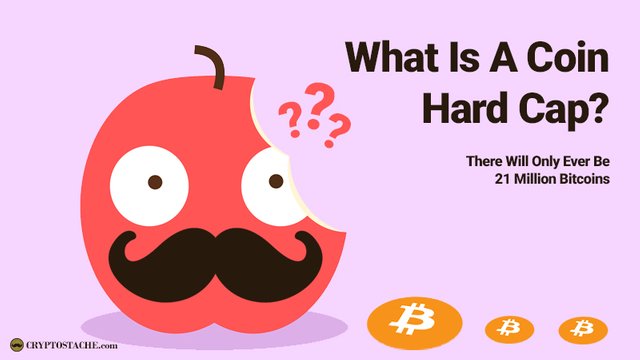
People ask me almost every day, "What gives Bitcoin value?" While I have written articles exclusively about what gives BTC value, one major aspect that I wanted to expand on is the fact that there will only ever be 21 million Bitcoin in existence. This what we call a "hard cap" or maximum supply and it plays a pretty large part in the valuation of a cryptocurrency. The hard cap can not be changed, it is part of Bitcoin's core features and code. The creator of Bitcoin, the mysterious Satoshi Nakamoto, created Bitcoin with a maximum supply of 21 million for a very good reason. Follow The 'Stache as I explain exactly what a hard cap is and why it is an important factor in determining if a coin is valued correctly.
Circulating VS Total VS Maximum Supply
The overall supply of a coin can be broken down into 3 main parts: Circulating Supply, Total Supply, & Maximum Supply. A great place to see this information, and my go-to source, is CoinMarketCap.com. They list out each type of supply (if a coin has each, more on that in a sec), and it helps to give you the big picture.
Circulating Supply is the amount of coins that are actively out in circulation being traded or held. Some projects have all their coins pre-mined, some release every coin from the start, while others you have to mine the coins over time, or they are released on a schedule. Regardless, circulating supply only refers to what is available at the moment.
Total Supply is the amount of coins that are in existence at the moment. These coins are created already, but they are not necessarily in circulation. An example would be the Federal Reserve printing a fresh batch of USD to get them ready for release. They are not yet in circulation, but would still count towards the total supply of all USD ever created.
Maximum Supply is the big one. This lets you know that a coin does in fact have a hard cap and denotes the amount of coins that will ever be in existence. In Bitcoin's case, the current Circulating Supply is 16,676,337 BTC, while the Maximum Supply is 21,000,000 which leaves 4,323,663 million Bitcoin left to come into existence through mining. (Check my article on mining Bitcoin here).
Coins With No Max Supply
Some cryptocurrencies have no maximum supply at all! These coins have various different rules as to how coins come into existence that vary slightly. Take into account the #2 cryptocurrency Ethereum. Ethereum has a current circulating supply of 95,688,485 ETH, but it has no maximum supply.
Why is this?
Well Ethereum has different rules governing the creating of new coins in comparison to Bitcoin. Ethereum uses block processing time and mining difficulty adjustments to control how much ETH can be mined. This is in place to not flood the market too quickly.
Putting Together The Pieces
Now that we know exactly what a hard cap or maximum supply is and why some coins have them and others don't we can use that information to make some basic assumptions of value and price. This is called Market Capitalization and is the base line for most people to calculate a cryptocurrencies value. It goes like this:
Price x Circulating Supply = Market Capitalization
This is how popular sites like CoinMarketCap.com calculate the over all market capitalization of a coin. While we have great resources like CoinMarketCap for the established coins and projects, where this information is REALLY REALLY useful is in the ICO market.
The ICO Wild West

Now with your new found knowledge, go forth and research those projects and determine for your self if they are truly worth investing in!

Information is not knowledge.
- Albert Einstein
Downvoting a post can decrease pending rewards and make it less visible. Common reasons:
Submit
Great quote! I wonder how old Albert would feel about saying that in this current "Information Golden Age"?
Downvoting a post can decrease pending rewards and make it less visible. Common reasons:
Submit
I feel that coins with a hard cap get more attention from investors. What do you think? Love the Stache equation :)))
Downvoting a post can decrease pending rewards and make it less visible. Common reasons:
Submit
I certainly give them more of my 'Stache lovein'! If a coin DOES NOT have a max supply, they need to have a really really good plan on how to deal with that. Typically coins like that are way "overvalued"
Downvoting a post can decrease pending rewards and make it less visible. Common reasons:
Submit
There is NO max supply for the amazing @originalworks
Downvoting a post can decrease pending rewards and make it less visible. Common reasons:
Submit